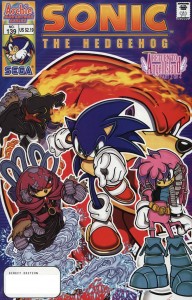 A lot can be said for having a character study in a strip that is otherwise full of action and adventure. While it’s fun to watch the hero punch the bad guy and save the day, you can only do so much. Without engaging characters at the center of the story, there’s no reason to keep on watching. Having one-dimensional hijinks from two-dimensional characters can only keep people intrigued for so long. Video games don’t have to be as great in the characterization department as a major motion picture, yes, but a person playing a game is expecting different things than the person sitting down and, say, reading an issue of Sonic the Hedgehog. I don’t need to know every detail of Eggman‘s motives as I run through the Green Hill Zone. In a comic, I need texture. Having 22 pages of Sonic running and jumping and saying nothing is not how you keep a comic book going for two decades.
A lot can be said for having a character study in a strip that is otherwise full of action and adventure. While it’s fun to watch the hero punch the bad guy and save the day, you can only do so much. Without engaging characters at the center of the story, there’s no reason to keep on watching. Having one-dimensional hijinks from two-dimensional characters can only keep people intrigued for so long. Video games don’t have to be as great in the characterization department as a major motion picture, yes, but a person playing a game is expecting different things than the person sitting down and, say, reading an issue of Sonic the Hedgehog. I don’t need to know every detail of Eggman‘s motives as I run through the Green Hill Zone. In a comic, I need texture. Having 22 pages of Sonic running and jumping and saying nothing is not how you keep a comic book going for two decades.
At the same time, you can’t have a comic book about Sonic be just a bunch of talking heads. You need a careful balance of exposition and explosions. Having the occasional issue where the characters are able to sit back and talk is important. Being able to examine everyone’s motives, explore their hopes and fears, and even having them grow in some fashion can keep people interested. Then you can go back to Sonic popping badniks and throwing out one-liners.
Ken was acutely aware of this as he tried to shift the comic towards the Saturday morning mindset, having extended plotlines showcasing the heroes with both victories and failures, not to mention the occasional introspective moment. But whatever balance he had in those early days seemed to disappear long before he got to writing Mobius: 25 Years Later. Having a hundred pages of flimsy character study with nothing else does not inspire your audience to read on.